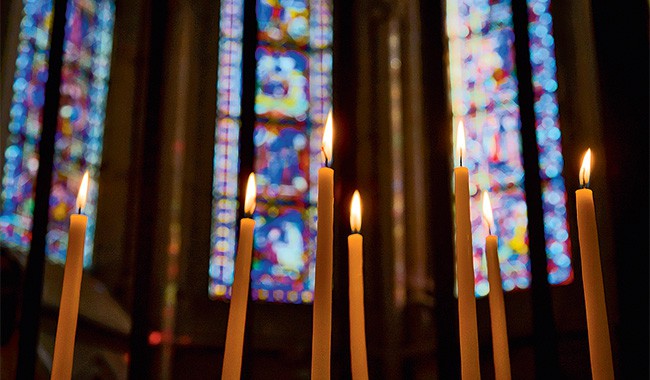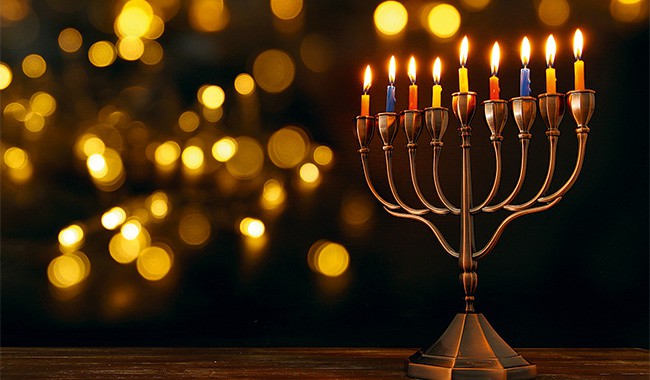Every year in December, Jewish children rejoice. It’s Hanukkah, known as the “festival of lights”: at nightfall, the whole family gathers around a nine-branch candlestick (a menorah also called chanukkiah). The center candle (the chamache which means “servant” in Hebrew) is lit first and allows the others to be set ablaze night after night.
On this occasion, the children are also showered with gifts, it’s very joyful… Because the Jews are commemorating a miracle and a rebirth there. ” It is a very popular holiday, summarizes Bruno Fiszon, chief rabbi of Metz and Moselle, which celebrates an important dimension of Jewish identity. »
More than 2000 years ago, in Jerusalem, the Jewish people had just won a battle against the Romans to defend their freedom. After the victory, the temple had to be purified by lighting the menorah with pure olive oil. But when there was barely a day left, the lamp burned for eight whole days, the time needed to make oil again!
” This miracle is proof that God has validated our fight,” comments Bruno Fiszon. Every year, in Metz, the chief rabbi invites Jean-Christophe Lagleize, bishop of the city, for the lighting of the last candle ” because there are connivances in spiritualities, an obvious filiation between Judaism and Christianity, we also celebrate monotheism. »
Wisdom and transmission
Every week, Jews also light Shabbat candles which have a utilitarian and spiritual vocation. From Friday at dusk until Saturday evening, they are forbidden to touch electricity (also forbidden to take the car, handle money, a Smartphone, the TV, etc.) in order to create an oasis in the time devoted to prayer, family and rest. From then on, so as not to be plunged into darkness, two flames light up the family table.
This pair of candles (to which is sometimes added one candle per child), blessed by the woman before serving the meal, symbolizes the harmony of the couple who come together for this occasion. We find these candles during Yom Kippur also called the “great Shabbat”. ” The candle conveys a meaning, explains Bruno Fiszon. It represents wisdom and the transmission of values. »
A flame is also lit when a loved one dies, on their grave and at home, throughout the year following the death, then on each anniversary date. ” The flame is like the soul of the deceased, comments the rabbi. You see the fire but you can’t catch it in your hand, just like the soul. The conviction of Judaism is that the essence of the person does not disappear with his death. »
Registered in the religious unconscious
The reality of fire is mysterious and terrifying. ” Archaically it is adapted to say something of the divine, expresses Laurent Stalla-Bourdillon, priest and teacher at the Collège des Bernardins. It signifies awareness of a transcendent reality. »
In Jewish and Christian traditions, God uses fire to come to the consciousness of man. The burning bush burns without being consumed, it is a fire that protects and speaks to the intelligence of Moses who finds himself faced with a reality that goes beyond him and puts him in touch with the sacred.
Among Catholics, the flame is also very present in the liturgy: the vegetal Advent wreath, with its four candles lit Sunday after Sunday until Christmas, signifies the path which makes it possible to welcome the unborn child, the “true” light. ” Fire has an undeniable spiritual nature, continues the priest. It allows us to come out of the darkness, of the nonsense, of the absurdity. It is very deeply inscribed in the religious unconscious. »

“The flame signs the presence of God”
For Catholics, the great major flame is the Paschal candle, lit on Easter night, blessed, to symbolize the light of the risen Christ. All participants in the vigil receive a small candle. It burns in churches until Pentecost and is used at baptisms and burials.
” The candles are the double of the one who prays and symbolically carry his prayer intention explains Laurent Stalla-Bourdillon, who recalls that the contemplation of a flame has a fascinating psychic effect and disposes the believer to welcome the Holy Spirit.
The Orthodox know something about it: in the churches, night lights burn permanently in front of the icons; Easter is the most intense time in the distribution of light literally and figuratively. The Orthodox priest comes out of the altar with a lighted candle to lavish it on all the participants.
” At the foot of the cross, in the altar, the flame burns permanently and signs the presence of God “, underlines Pierre Kazarian-Toumanoff, responsible for services in French at the Saint-Stéphane cathedral, in Paris.
“The mission of every Christian is to shine the light of Christ”
Among Evangelicals and Reformed Protestants, on the other hand, there are no candles. ” We stripped ourselves of the elements of the Catholic liturgy at the time of the Reformationexplains Thierry Le Gall, evangelical pastor. For us, the mission of every Christian is to shine the light of Christ. In a figurative sense and without using fire, therefore.
In Islam, candles are only used by certain Sufi brotherhoods, as can be seen in Fez (Morocco) at the tomb of Sufi saints, and absolutely not widespread.
Indispensable actor and framing of the liturgy among Jews, Catholics and Orthodox, fire has also become secularized. The Republic has appropriated this symbolism, through the flame of the unknown soldier which burns tirelessly under the Arc de Triomphe.
” The great unity of prayer in our society, whatever the religion, is around the candle remarks Pierre Kazarian-Toumanoff. During the 2015 attacks on Charlie Hebdo, the terraces and the Bataclan, thousands of flames were lit like so many prayers for the murdered. And to add that Paris is one of the rare capitals to light up at night, igniting the Eiffel Tower, like a secular, protective and benevolent candle placed on the city.
Candles, symbol of an elusive religious mystery: “Fire has an undeniable spiritual nature”

